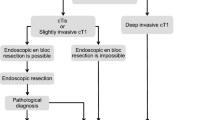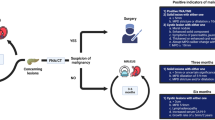Abstract
Background
Current guidelines for the surveillance colonoscopy interval are largely based on the most recent colonoscopy findings.
Aim
We aimed to evaluate differences in the probability of high-risk neoplasm recurrence according to the two previous colonoscopy findings.
Methods
This was a retrospective cohort study from a tertiary-care center. A total of 4,143 subjects who underwent three or more colonoscopies for screening or surveillance purposes from January 2001 to December 2011 were enrolled. We compared the probability of high-risk neoplasm detection on follow-up colonoscopies after the second colonoscopy based on risk categories in both the second and first colonoscopies.
Results
At the final colonoscopy, 370 participants (8.9 %) had high-risk neoplasms. In patients with a normal second colonoscopy, the probability of high-risk neoplasm recurrence was different between those with normal, low-risk, and high-risk findings at the first colonoscopy (3.8, 6.8, and 17.7 %, respectively). The hazard ratio of a high-risk neoplasm at the final colonoscopy for patients with a normal second and low-risk first colonoscopy over a normal second and normal first colonoscopy was 3.07 (95 % CI 2.04–4.64, P < 0.001). The hazard ratio of high-risk neoplasm at the final colonoscopy for patients with a normal second and high-risk first colonoscopy over a normal second with normal first colonoscopy was 7.88 (95 % CI 4.90–12.67, P < 0.001).
Conclusions
The rate of high-risk colorectal neoplasm recurrence differs according to the two previous colonoscopy findings. Therefore, surveillance intervals could be adjusted not just only by the most recent colonoscopy findings but also by considering two previous colonoscopy findings.



Similar content being viewed by others
References
Baxter NN, Goldwasser MA, Paszat LF, et al. Association of colonoscopy and death from colorectal cancer. Ann Intern Med. 2009;150:1–8.
Brenner H, Chang-Claude J, Seiler CM, Rickert A, Hoffmeister M. Protection from colorectal cancer after colonoscopy: a population-based, case-control study. Ann Intern Med. 2011;154:22–30.
Doubeni CA, Weinmann S, Adams K, et al. Screening colonoscopy and risk for incident late-stage colorectal cancer diagnosis in average-risk adults: a nested case-control study. Ann Intern Med. 2013;158:312–320.
Avidan B, Sonnenberg A, Schnell TG, Leya J, Metz A, Sontag SJ. New occurrence and recurrence of neoplasms within 5 years of a screening colonoscopy. Am J Gastroenterol. 2002;97:1524–1529.
Chung SJ, Kim YS, Yang SY, et al. Five-year risk for advanced colorectal neoplasia after initial colonoscopy according to the baseline risk stratification: a prospective study in 2452 asymptomatic Koreans. Gut. 2011;60:1537–1543.
Laiyemo AO, Doubeni C, Brim H, et al. Short- and long-term risk of colorectal adenoma recurrence among whites and blacks. Gastrointest Endosc. 2013;77:447–454.
Lieberman DA, Weiss DG, Harford WV, et al. Five-year colon surveillance after screening colonoscopy. Gastroenterology. 2007;133:1077–1085.
Lieberman DA, Rex DK, Winawer SJ, et al. Guidelines for colonoscopy surveillance after screening and polypectomy: a consensus update by the US Multi-Society Task Force on Colorectal Cancer. Gastroenterology. 2012;143:844–857.
Davila RE, Rajan E, Baron TH, et al. ASGE guideline: colorectal cancer screening and surveillance. Gastrointest Endosc. 2006;63:546–557.
van Heijningen EM, Lansdorp-Vogelaar I, Kuipers EJ, et al. Features of adenoma and colonoscopy associated with recurrent colorectal neoplasia based on a large community-based study. Gastroenterology. 2013;144:1410–1418.
Cairns SR, Scholefield JH, Steele RJ, et al. Guidelines for colorectal cancer screening and surveillance in moderate and high risk groups (update from 2002). Gut. 2010;59:666–689.
Laiyemo AO, Pinsky PF, Marcus PM, et al. Utilization and yield of surveillance colonoscopy in the continued follow-up study of the polyp prevention trial. Clin Gastroenterol Hepatol. 2009;7:562–567; quiz 497.
Pinsky PF, Schoen RE, Weissfeld JL, et al. The yield of surveillance colonoscopy by adenoma history and time to examination. Clin Gastroenterol Hepatol. 2009;7:86–92.
Robertson DJ, Burke CA, Welch HG, et al. Using the results of a baseline and a surveillance colonoscopy to predict recurrent adenomas with high-risk characteristics. Ann Intern Med. 2009;151:103–109.
Morelli MS, Glowinski EA, Juluri R, Johnson CS, Imperiale TF. Yield of the second surveillance colonoscopy based on the results of the index and first surveillance colonoscopies. Endoscopy.. 2013;45:821–826.
Grambsch PM, Therneau TM. Proportional hazards tests and diagnostics based on weighted residuals. Biometrika. 1994;81:515–526.
Levin B, Lieberman DA, McFarland B, et al. Screening and surveillance for the early detection of colorectal cancer and adenomatous polyps, 2008: a joint guideline from the American Cancer Society, the US Multi-Society Task Force on Colorectal Cancer, and the American College of Radiology. Gastroenterology. 2008;134:1570–1595.
Martinez ME, Baron JA, Lieberman DA, et al. A pooled analysis of advanced colorectal neoplasia diagnoses after colonoscopic polypectomy. Gastroenterology. 2009;136:832–841.
Ashbeck EL, Jacobs ET, Martinez ME, Gerner EW, Lance P, Thompson PA. Components of metabolic syndrome and metachronous colorectal neoplasia. Cancer Epidemiol Biomarkers Prev. 2009;18:1134–1143.
Moore JB. Nonalcoholic fatty liver disease: the hepatic consequence of obesity and the metabolic syndrome. Proc Nutr Soc. 2010;69:211–220.
Yang DH, Hong SN, Kim YH, et al. Korean guidelines for postpolypectomy colonoscopy surveillance. Clin Endosc. 2012;45:44–61.
Conflict of interest
None.
Author information
Authors and Affiliations
Corresponding author
Additional information
Hye Won Park and Seungbong Han have contributed equally to this study.
Rights and permissions
About this article
Cite this article
Park, H.W., Han, S., Lee, J.Y. et al. Probability of High-Risk Colorectal Neoplasm Recurrence Based on the Results of Two Previous Colonoscopies. Dig Dis Sci 60, 226–233 (2015). https://doi.org/10.1007/s10620-014-3334-9
Received:
Accepted:
Published:
Issue Date:
DOI: https://doi.org/10.1007/s10620-014-3334-9




